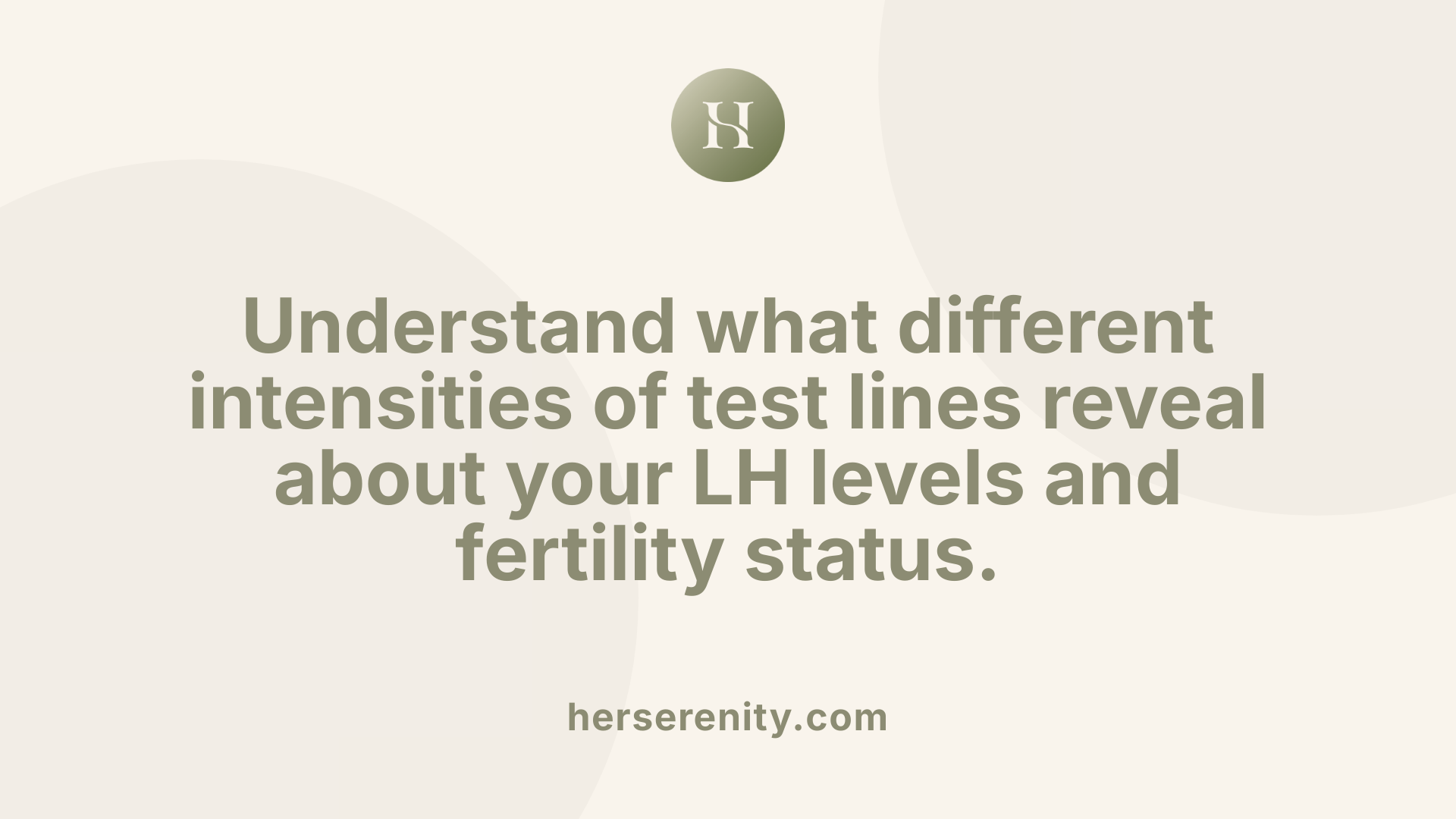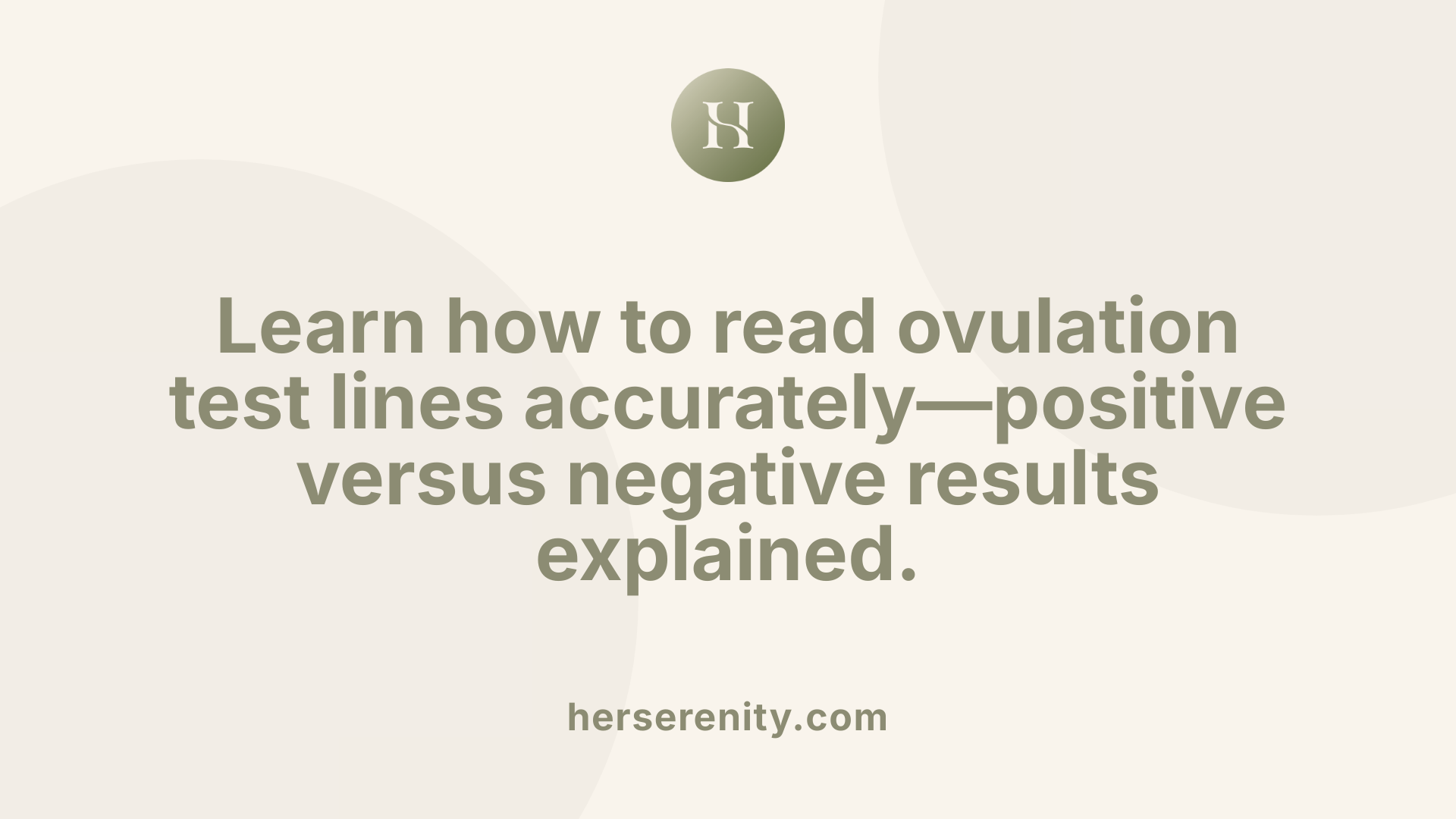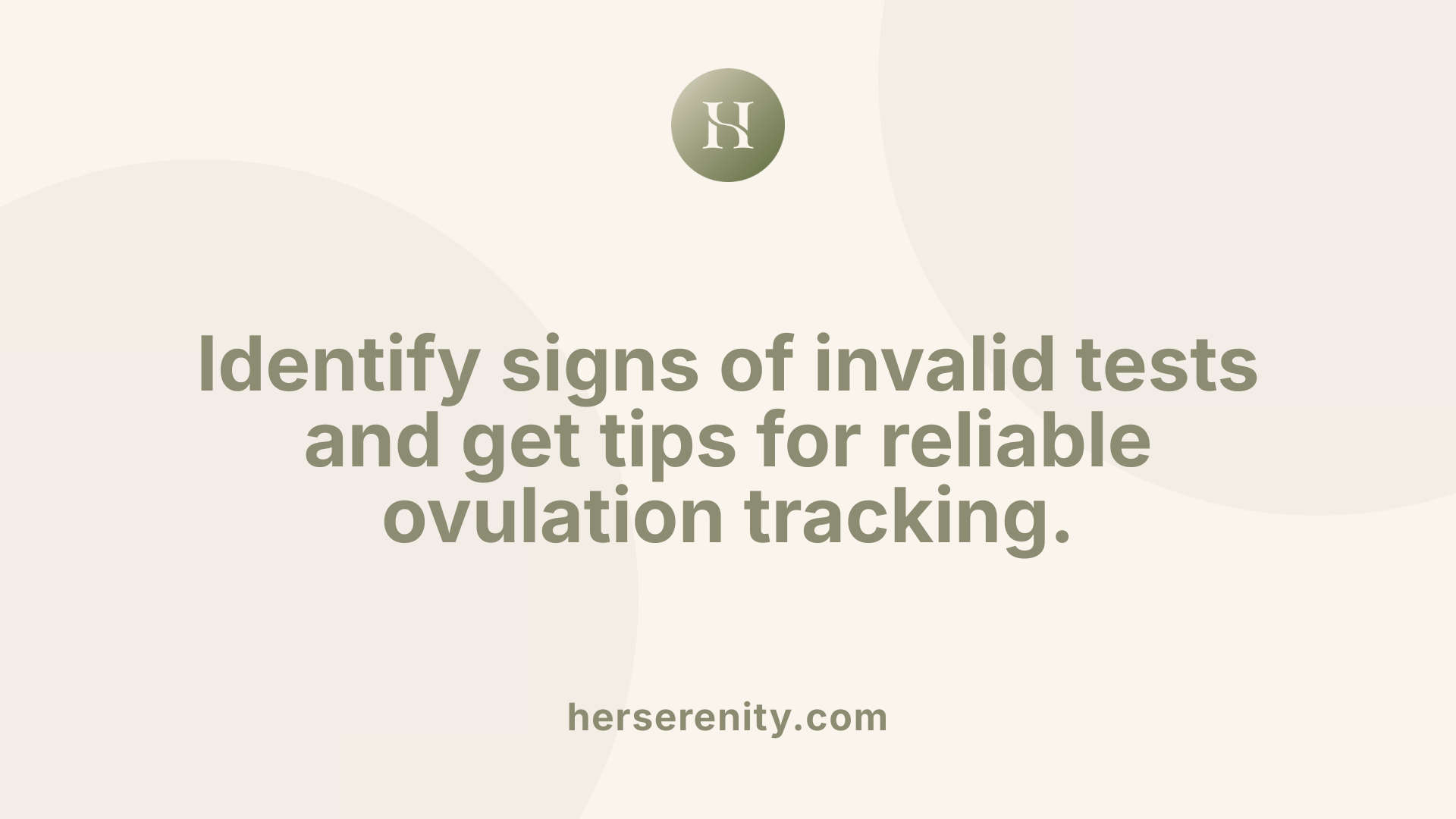How to interpret your ovulation test results
Mastering Ovulation Tests: A Complete Guide to Fertility Awareness

Understanding Ovulation Test Results and Their Role in Conception
Ovulation tests are a vital tool for women trying to understand their fertility cycle and pinpoint their most fertile days. By carefully interpreting test results, women can optimize their chances of conceiving. This guide explores how to read ovulation test lines, recognize true positives, distinguish invalid results, and leverage hormone patterns for better fertility tracking.
Understanding How Ovulation Tests Work
What do ovulation test kits measure?
Ovulation test kits are designed to detect the presence and levels of hormones in urine that indicate ovulation. Primarily, they measure luteinizing hormone (LH), which surges just before ovulation. Some advanced kits also track other hormones like estrogen and FSH to provide a broader picture of fertility.
Difference between control line and test line
On a typical strip test, you'll see two lines: the control line and the test line. The control line serves as a validity check, showing that the test has worked correctly. The test line indicates hormone levels, specifically LH. If the test line appears as dark as or darker than the control line, it signals a high LH level, suggesting that ovulation is imminent or occurring. A lighter test line means LH levels are low, and ovulation has not yet happened.
How hormone levels influence test results
LH levels vary throughout the menstrual cycle. During the early phase, LH remains low and steady, generally between 1.37 and 9 IU/L. About 24 to 36 hours before ovulation, LH surges sharply, often exceeding 30 IU/L and reaching peak levels between approximately 12.2 and 118.0 mIU/mL, with an average around 44.6 mIU/mL. This surge triggers ovulation—the release of a mature egg.
After ovulation, LH levels decrease back to baseline during the luteal phase, usually between 1.09 and 9.2 IU/L. Analyzing LH levels through test lines helps women pinpoint the most fertile days. When the LH surge is detected, it indicates that ovulation is likely to occur within the next 24 to 36 hours. Conversely, low or negative test results reveal that the fertile window has not yet begun or has passed.
Understanding these hormone fluctuations and how they reflect in test lines can significantly improve fertility tracking and enhance conception chances.
Additional insights into hormone testing
Some tests measure other hormones, such as estradiol, which can provide further information about fertility status. The combination of hormone levels and patterns, along with other signs like basal body temperature and cervical mucus changes, offers a comprehensive approach to understanding ovulation.
| Hormone | Cycle Phase | Typical Levels | Indicator | Significance |
|---|---|---|---|---|
| LH | Pre-ovulation surge | 1.37-9 IU/L (baseline); >30 IU/L (surge) | Test line as dark or darker than control line | Ovulation approaching or happening |
| Estrogen | Late follicular phase | Increasing towards ovulation | High levels signal fertility window | Prepares body for ovulation |
| FSH | Follicular phase | 3-10 IU/L | Supports follicle development | Cultivates the environment for ovulation |
These patterns help women identify their fertile days, optimizing timing for conception.
Deciphering Test Lines: What Do They Signify?

How to recognize positive, negative, and invalid results
Interpreting ovulation test lines correctly is crucial for understanding your fertility status. A positive result occurs when the test line is as dark or darker than the control line, indicating a surge in luteinizing hormone (LH). This surge suggests that ovulation is likely imminent or occurring within the next 24 to 36 hours. A negative result is shown when the test line is lighter than the control line or absent altogether. This means LH levels are not currently high enough to signal ovulation. Invalid results happen when the control line does not appear, which indicates the test did not work properly. In such cases, the test should be repeated with a new strip or digital device for an accurate reading.
Color intensity and its meaning
The brightness or darkness of the test line directly correlates with hormone levels in urine. A darker line indicates higher LH concentrations, whereas a lighter line signifies lower levels. When the LH surge begins, the test line often becomes as dark as or darker than the control line. If the line remains faint or barely visible, it suggests LH levels are still low and ovulation has not yet started. It is often recommended to test at the same time every day, preferably in the afternoon or early evening, to better track the progression of LH levels.
The significance of lines as dark as or darker than the control
When the test line is as dark as or darker than the control line, it signals a positive result. This indicates that LH levels have surged past the detection threshold, which usually points to ovulation occurring within the next 24-36 hours. Such a result is the optimal window for conception because the egg is released during this period, and sperm can survive inside the reproductive tract for several days. Multiple days of positive tests may occur, especially if LH levels gradually rise, but the last highest peak generally marks the most fertile day. Understanding what these line intensities mean helps women pinpoint their most fertile days and time intercourse accordingly.
How do hormone levels, especially LH, fluctuate during the menstrual cycle, and what do they indicate?
Throughout the menstrual cycle, LH levels fluctuate dramatically. During the early follicular phase, LH remains low and steady, usually between 1.37 to 9 IU/L. About 24-36 hours before ovulation, LH surges sharply, often reaching levels of 12.2 to 118.0 mIU/mL, with an average roughly around 44.6 mIU/mL. This LH peak triggers the final maturation of the egg and its release from the ovary. Following ovulation, LH levels decline back to baseline, typically between 1.09 to 9.2 IU/L, during the luteal phase. A pronounced LH surge indicated by high test line intensity on ovulation kits marks the most fertile window. Hormonal imbalances or conditions such as PCOS can cause abnormal LH levels, leading to irregular cycles or false positives in test results. Regular hormonal fluctuations signal healthy cyclic ovulation, vital for conception, while anomalies may require medical consultation.
| Cycle Phase | LH Levels (IU/L or mIU/mL) | Significance | Additional Notes |
|---|---|---|---|
| Early follicular | 1.37 - 9 | Low and steady, no ovulation imminent | Starting point of cycle |
| Pre-ovulatory surge | Up to 118.0 | Ovulation likely within 24-36 hours | Peak fertility period |
| Luteal phase | 1.09 - 9.2 | Post-ovulation, preparing for menstruation | Hormone levels decline |
Knowing how hormone levels fluctuate helps women understand their cycle better and optimize timing for conception. Accurate interpretation of test lines, combined with other signs like cervical mucus and basal body temperature, can significantly enhance fertility tracking.
Interpreting the Results: When Is the Test Positive or Negative?
 Understanding how to interpret ovulation test results is crucial for accurately pinpointing your fertile window. The test involves comparing the test line to the control line on the strip or digital display.
Understanding how to interpret ovulation test results is crucial for accurately pinpointing your fertile window. The test involves comparing the test line to the control line on the strip or digital display.
Matching test line to control line
The control line serves as an indicator that the test is functioning correctly. The test line reflects the level of luteinizing hormone (LH) in your urine. A positive result is when the test line is as dark as or darker than the control line, indicating a high LH level. Conversely, if the test line is lighter than the control line or not visible, the result is negative, suggesting LH levels are low.
What constitutes a positive result?
A positive ovulation test signifies that an LH surge is occurring. This surge happens typically 24 to 36 hours before ovulation. When the test line is equal to or darker than the control line, it indicates peak LH levels, and ovulation is likely imminent. Digital tests make this easier to read by showing icons such as a smiley face or words like “peak fertility,” confirming the surge.
Timing of reading test results
For accurate interpretation, it’s best to read the test results within about 5 minutes of applying the urine sample. Results interpreted after this window might be inaccurate, as lines can fade or develop further over time. Testing at the same general time each day, ideally mid-morning to early afternoon, helps in consistent monitoring.
Are positive ovulation test results reliable indicators of ovulation, and how should they be interpreted?
Positive ovulation tests — where the test line mimics or exceeds the control line’s darkness — are highly reliable indicators that your body is experiencing an LH surge. This surge signals that ovulation is likely to occur within the next 12 to 36 hours.
While a positive test generally alerts you to your most fertile days, it’s important to remember that the LH surge itself doesn’t guarantee ovulation, which is a biological process that can sometimes be delayed or affected by medical conditions. Digital tests with surge icons can help eliminate interpretation errors.
It's recommended to perform daily testing during your fertile window, especially in the days leading up to expected ovulation. Combining this data with other signs of ovulation, like basal body temperature and changes in cervical mucus, can provide a fuller picture of your cycle.
In summary, a positive ovulation test is a strong sign of impending ovulation. Proper timing, consistent testing, and accurate interpretation are essential for maximizing your chances of conception.
How Long Do Ovulation Tests Stay Positive?

How long does an ovulation test usually stay positive, and what does this mean for tracking fertility?
An ovulation test typically shows a positive result for about 24 to 48 hours during the LH surge. This surge in luteinizing hormone (LH) occurs roughly 24 to 36 hours before ovulation, signaling that the egg is about to be released. When the test line is as dark or darker than the control line, it indicates a high LH level, which is a strong sign that ovulation will happen soon. The positive result helps pinpoint the most fertile period in a woman’s cycle, especially when combined with other signs like basal body temperature or cervical mucus. Tracking how long the test remains positive is crucial for understanding fertility timing. A sustained positive over multiple days could mean a prolonged LH surge or multiple peaks, both of which may influence the timing of conception efforts. Since the LH surge can vary in length across women, observing pattern changes over several cycles can improve predictions. Typically, a single positive test indicates that ovulation is near, but if the test remains positive for more than two days, it may warrant further observation or consultation with a healthcare provider. In short, a positive ovulation test signals that the body is preparing for ovulation, and this window usually lasts one to two days. To maximize fertility, it is recommended to have intercourse during this fertile window, especially on days when the test is positive or just before when the LH surge begins. Understanding the duration and pattern of positive results enhances fertility tracking efforts, helping women better plan conception attempts and recognize any irregularities that might affect their cycle.
Reliability of Ovulation Tests and Their Limitations

Are positive ovulation test results reliable indicators of ovulation, and how should they be interpreted?
Ovulation tests are designed to detect the surge in luteinizing hormone (LH) that occurs approximately 24 to 36 hours before ovulation. A positive test result, shown by a test line that is as dark or darker than the control line, indicates a significant rise in LH levels. This surge suggests that ovulation is likely to happen within the next 12 to 36 hours, making it a useful marker for timing conception.
Digital ovulation tests often provide additional clarity by displaying icons such as 'yes,' 'no,' or smiley faces, signaling whether the LH surge is detected. To improve accuracy, it is recommended to perform daily tests over several days during the fertile window. This approach helps ensure the LH peak is not missed, especially since LH surges can be brief or vary in pattern.
While a positive result strongly indicates that the body is preparing for ovulation, it does not directly confirm that ovulation has already occurred. Negative results, where the test line is lighter than the control line or absent, do not guarantee that ovulation will not happen later. Therefore, combining ovulation tests with other methods like basal body temperature tracking, which increases after ovulation, can provide a more comprehensive view of fertility status.
In summary, positive ovulation test results are reliable signs of an LH surge and a likely upcoming ovulation, yet they are not infallible. Understanding the timing and limitations of these tests can help women maximize their chances of conception, but they should be used as part of a broader fertility awareness strategy.
Recognizing Invalid and Inconclusive Results

What does an invalid ovulation test result look like, and what should be done?
An invalid ovulation test result can present itself in several ways. You might see no lines at all, very faint lines that are hard to interpret, or lines that appear inconsistent or unclear. These signals mean the result cannot be trusted as accurate.
Invalid results may occur due to various reasons, including issues with the test device itself, improper testing technique, or using a kit that has expired or been stored incorrectly.
To address invalid results, it is advisable to repeat the test with a new, properly stored kit. Make sure to carefully follow the manufacturer's instructions, such as timing the test correctly and avoiding excessive fluid intake immediately before testing, which can dilute hormone concentration.
If you experience multiple invalid results despite proper testing, it may be beneficial to consult a healthcare professional. Underlying conditions like polycystic ovary syndrome (PCOS), thyroid imbalances, or other hormonal issues can affect test accuracy.
Another useful approach is to combine ovulation testing with physical signs like changes in cervical mucus or basal body temperature. Using digital tests or those that measure multiple hormones can also enhance reliability and provide a clearer picture of your fertility cycle.
Being aware of these signs and steps can help you interpret your results better and maintain an effective ovulation tracking routine.
Putting It All Together: Making the Most of Your Ovulation Testing
Interpreting ovulation test results accurately is crucial for understanding your fertility cycle and optimizing your chances of conception. Recognizing positive results, understanding hormone fluctuations, and identifying invalid tests are all vital skills. Complementing test results with other ovulation indicators like basal body temperature and cervical mucus can provide a comprehensive picture of your fertility window. Remember to follow testing guidelines diligently, and consult healthcare professionals if irregular patterns or uncertainties arise. With careful interpretation, ovulation tests are powerful tools in your journey toward conception.
References
- How to Read Ovulation Test Results - Pregnancy - WebMD
- How to interpret ovulation test results - myLAB Box
- Using ovulation tools to predict fertility - Mayo Clinic Health System
- Ovulation Test Strips Instructions for Use - pregmate
- Advanced Digital Ovulation Test: Typically identifies 4 or ... - Clearblue
- How Do I Read An Ovulation Test? - ELITE IVF
- LH Surge vs LH Peak on Ovulation Tests: Mean For Getting Pregnant



































































































